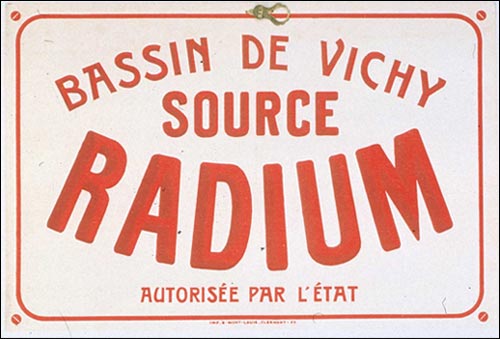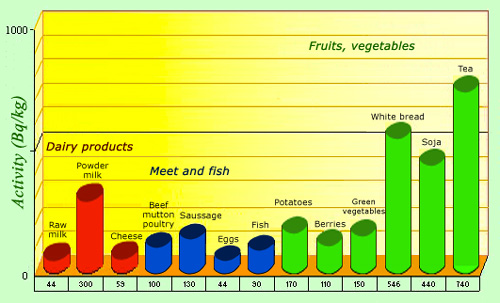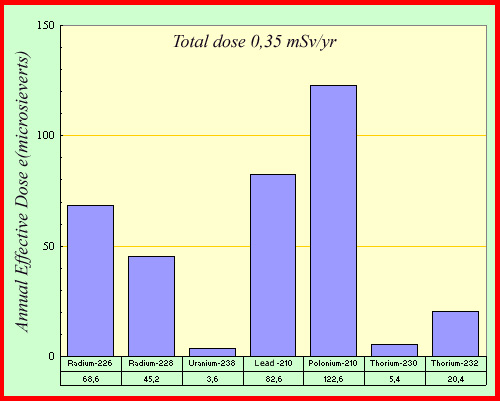In our glasses and on our plates …

An out-of-date publicity campaign…
One cannot escape from radioactivity. Granite rocks are lightly radioactive owing to the presence of thorium, uranium and their radioactive descendants. A celebrated thermal source used this feature as an advantage when radioactivity was being cheered by the public in the 1930s. Seventy years later, another source from the same region prefers using the smile of the popular soccer player Zinedine Zidane superimposed to proclaim the quality of its water. The low levels of radioactivity, however, mean that both waters are perfectly healthy.
© ANDRA
The very acts of breathing and walking around make it impossible for us to escape radioactivity. We also regularly come into contact with radiations when we eat: all foodstuffs are slightly radioactive due to their content of carbon 14 and potassium 40 – radioisotopes that are present wherever regular carbon and potassium can be found.

Food is naturally radioactive !
The food we eat is lightly radioactive, as we can see from the levels measured in various different foodstuffs. Activities of several hundred becquerels (Bq) per kilogram or litre may seem high, but the bequerel is a very small unit : the body of a 70kg man has a natural activity of 8000 Bq.
© IN2P3
The spring water that we drink is also radioactive. Before bursting out of the ground it has dissolved various mineral salts from its underground path, including a large variety of radioisotopes. The most radioactive waters come from areas with granite or volcanic rocks, where uranium, thorium and their descendants are present in the ground. The exposure levels here, however, vary wildly.

Radioactivity of spring water:
Water contains small amounts of radioactivity owing to radioactive rocks. As an example, the above graph displays the annual dose one would receive from a granitic spring water, supposing that one drinks a litre of this water every day for a whole year. This study shows that the contribution to the annual dose would be a fraction of millisievert (mSv) to be compared to the 2,4 mSv average dose due to natural radioactiviry.
IN2P3
In the United States, the average activity of household drinking water is of 18.5 Bq/litre, which corresponds to a truly inconsequential risk given the tiny value of the becquerel. Today, legislation places upper bounds on the activities food and drink can have – owing to our ignorance about the effects of low doses of radioactivity, caution is the watchword.
One of the reproaches made to the French radioprotection authorities after the Chernobyl accident was that they had not prevented the distribution of products whose activities surpassed the recommended limits. These ‘high’ levels were probably too small to have had an effect in any case, but the perceived lack of administrative transparency and the feeling that dangers were being hidden all undermined the trust the public had in the experts. The shock waves of this psychological disaster are still reverberating through modern society.

Upper limits
The graph shows the maximum dose allowed in the European Community for different radioactive elements in three different food categories. The limits are given in terms of activity (becquerels) per kilogram. The more radiotoxic the radioelement is (the most dangerous being alpha emitters such as plutonium), the weaker the activity has to be. This is especially true in the case of baby food, where limits are particularly strict. When it comes to food which is consumed in small quantities (under 10 kilograms a year), activities up to ten times greater than those shown above can be allowed.
© IN2P3
Much like the legal limitations on alcohol consumption prior to driving, the limits on radiation exposure have been steadily decreasing over the past fifteen years. As always, the risks are taken overly seriously in order to keep public safety as high as possible. Paradoxically, however, the exaggeration of these risks has led to more worry and unease among the general public as to the dangers of radioactivity and ionising radiatons.
An other example of these baseless worries is the concern which surrounds the irradiation of food. Irradiation is a highly effective method of sterilization which does not affect taste and, according to the WHO, leaves no radioactive traces. Pepper and various spices, for instance, which are very easily contaminated by dangerous bacteria, were until recently regularly exposed to sterilizing radiation. New regulations, however, required ‘sterilization by ionisation’ to be written on the packaging, which prompted several companies to back away from predicted panic and revert to less effective, more dangerous methods.
Other articles on the subject « Natural Radioactivity »
Natural Origins
From vestiges of earth formation to cosmic rays Despite having evolved under constant exposure to[...]
Uranium and thorium origins
Radioactive substances older than the Earth The principal source of natural radiations on Earth i[...]
Cosmogenic Radioelements
Formation of radioactive atoms from cosmic rays The Earth is constantly being bombarded by ‘[...]
Natural Exposure
A chronic but benign exposure All exposure to radioactivity, whether natural or artificial, is me[...]
Ground Radioactivity
Telluric Exposure : Radiation which emanates from rocks The Earth crust contains a number of radi[...]
Human Internal Exposure
Our bodies are also… slightly radioactive All through our lives, we inhale and ingest radio[...]